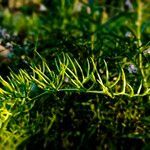Sterile fronds narrowly ovate to ovate to deltoid or cordate (2-)6.5-59 by 1.3-20 cm; stipes (0.2-)2-31 by 0.7-8 mm at their broadest point near the base; blade pinnate to frequently bipinnate with deeply incised pinnules to tripinnate; pinnae lobed or incised, elliptic to narrowly ovate to deltoid 1-12.5 cm long; lowermost pinnae inserted mostly alternately on the stipe; bud initials frequent in pinnule sinuses, mostly dormant on living fronds. Fertile fronds erect, narrowly ovate to ovate to deltoid or cordate, longer than sterile fronds, (1.8-)9-117 by (0.6-)2.4-48 cm; stipes (0.8-4)-46 cm by 1-11 mm at their broadest point; blades tripinnate to quandripinnate below, bipinnate above with narrowly ovate to deltoid to ovate pinnae, the lowermost 2-36 cm long and mostly inserted alternately on the stipe; terminal segments linear to deltoid, rounded, acute to attenuate at tips with margins inrolled to enclose 1-3 rows of mature sporangia; sporangia with (13-)20-71 indurated annulus cells; spores 32 per sporangium, 96-124 mm in distal diameter.
A fern which grows in water. It is an annual plant. It grows 10-35 cm tall. It has soft upright stalks with light green soft fronds. The rhizome is short and sticks up. There are thin, clear, scales on the rhizome. The leaves vary from simple leaves, to leaves which are divided 3 times. The stem is anchored in mud. It grows as tufted clumps. Leaves are like carrot tops. The stem of the frond is spongy and air filled. It can grow under the water or be free floating. It produces small plants on the fronds. The fertile fronds which produce the spores, are longer and more finely divided, than the other fronds. They are more stiff and erect and turn brown when mature. The plant only lasts a few months.
Plants usually rooted in soil. Sterile leaves lanceolate to lance-ovate to ovate to deltate or cordate. Petiole of sterile leaf 1--31 cm, not inflated. Blade of sterile leaf 1--3-pinnate, 2--41 × 2--20 cm; segments lobed or incised, elliptic to lanceolate to ovate or deltate, to 12.5 cm; proximal pinnae ± alternate. Fertile leaves lanceolate to ovate to deltate or cordate, 2--117 × 2--48 cm. Petiole of fertile leaf 1--46 cm. Blade of fertile leaf 3--4-pinnate proximally, 2-pinnate distally; terminal segments linear. Sporangia usually crowded between segment midvein and revolute margin, with 13--71 indurate annulus cells. Spores 32 per sporangium, 96--124 µm diam. 2 n = 154, 156.
Fronds tufted, succulent and brittle. Sterile fronds erect or spreading; stipe c. 2-30 cm long; lamina commonly 1-3-pinnate, ovate, more rarely broadly triangular, 4-40 cm long, 1-20 cm wide; pinna segments oblong to irregularly shaped, to 5 mm wide in larger fronds; buds often present in pinna-sinuses but mostly dormant on living fronds. Fertile fronds erect; lamina commonly 3-4 (-6)-pinnate, 2-pinnate above, ovate to broadly triangular, commonly 5-65 cm long, 4-30 cm wide; segments ±linear; margins recurved enclosing 1-3 rows of sporangia.


